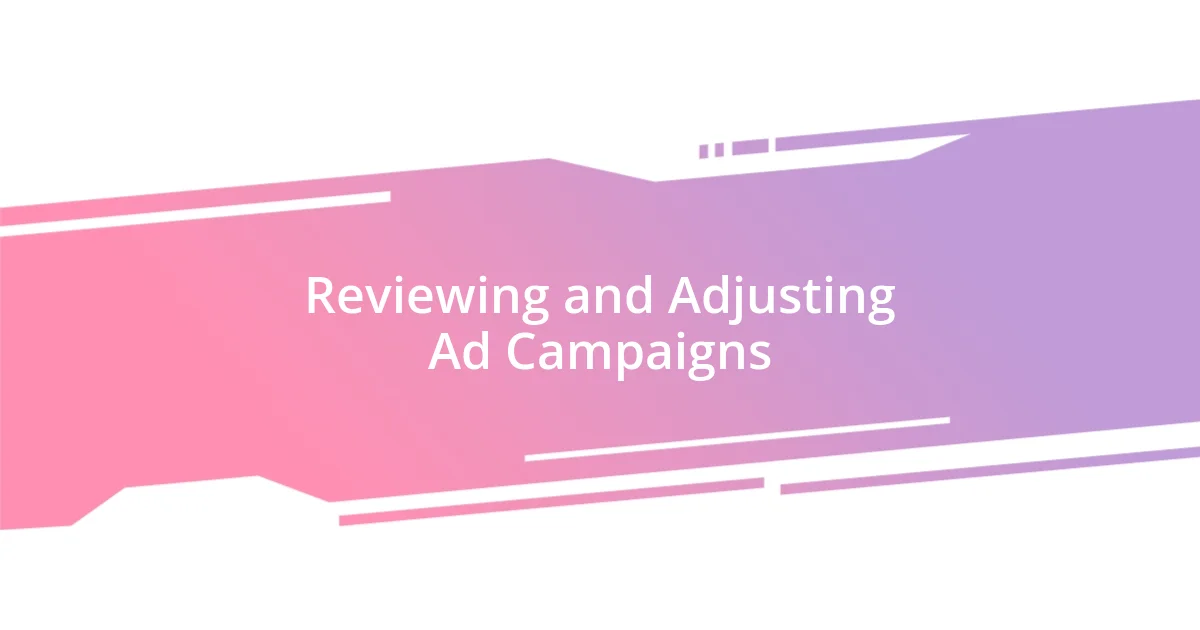Key takeaways:
- Ad spend efficiency relies on reallocating funds from underperforming ads to maximize returns, demonstrated by a 40% increase in leads through strategic analysis of performance metrics.
- Identifying key performance indicators (KPIs) such as conversion rate and return on ad spend (ROAS) is essential for aligning ad efforts with business goals and ensuring meaningful customer interactions.
- Regularly reviewing and adjusting campaigns based on performance data allows for agile decision-making, leading to improved engagement and effective budget reallocation.

Understanding Ad Spend Efficiency
Understanding ad spend efficiency is crucial for any marketer looking to maximize their return on investment. I remember launching a campaign where I meticulously tracked every dollar, and that data revealed surprising insights. It was eye-opening to see that some ads I thought would perform well simply didn’t resonate with my audience, while others I had doubts about exceeded all expectations.
Think about the value of each click. Does it contribute to your goals? In one of my campaigns, reallocating funds from underperforming ads to those with higher engagement resulted in a 40% increase in leads. This experience taught me that it’s not just about spending money but spending it wisely. Analyzing performance metrics enabled me to focus on what truly matters, fostering a sense of purpose in my advertising efforts.
Ultimately, ad spend efficiency isn’t just about cutting costs; it’s about investing thoughtfully. Each decision shaped by data instilled a greater confidence in my strategy. I often ask myself, “How can I refine my approach to elicit an even stronger emotional response from my audience?” These reflections have not only improved my campaigns but also deepened my connection to the work I love.

Identifying Key Performance Indicators
Identifying the right key performance indicators (KPIs) is essential for measuring the effectiveness of your ad spend. In my early days of advertising, I focused on vanity metrics like impressions, but I quickly learned that they didn’t tell the full story. I remember a campaign where high click-through rates left me feeling overconfident. It wasn’t until I looked at conversion rates that the reality sank in—my audience was clicking but not taking action. This moment was a turning point that emphasized the importance of aligning KPIs with actual business goals.
Here are some crucial KPIs I recommend focusing on:
- Click-Through Rate (CTR): This indicates how well your ad is attracting attention.
- Conversion Rate: The percentage of users who complete a desired action, like making a purchase.
- Cost Per Acquisition (CPA): Understanding how much you’re spending to gain a customer is vital.
- Return on Ad Spend (ROAS): This measures the revenue generated for every dollar spent on ads.
- Customer Lifetime Value (CLV): Knowing how much a customer is worth over their relationship with your brand can guide future expenditures.
By honing in on these metrics, I’ve been able to navigate my ad strategies with much more precision and purpose. Identifying KPIs isn’t just about tracking numbers; it’s about ensuring that every dollar spent translates into meaningful customer interactions and sustainable growth.

Setting Clear Advertising Goals
Setting clear advertising goals is the cornerstone of any successful campaign. I’ve found that having specific, measurable, attainable, relevant, and time-bound (SMART) goals allows me to direct my ad spend more effectively. For instance, instead of vaguely aiming for more sales, I set a goal to increase my monthly revenue by 20% through targeted ads during the upcoming quarter. This clarity not only guided my decision-making but also fueled my motivation, making me more passionate about each campaign.
Every campaign deserves its own unique set of goals based on varying target audiences and product offerings. I remember when I launched a seasonal promotion; instead of generalizing, I segmented my goals. For the summer campaign, I aimed to attract first-time customers, while for the holiday season, my focus was on repeat purchases. This dual approach allowed me to tailor my messaging, resulting in a 30% increase in engagement compared to previous years. I realized that specificity in goals led to creativity in strategy, keeping my audience engaged and my spending efficient.
It’s essential to revisit and adjust goals as needed to stay aligned with market dynamics and business objectives. Reflecting on one of my earlier experiences, I had set an ambitious goal that I later realized wasn’t budding in the current market conditions. Adjusting my targets and focusing on realistic, short-term objectives helped steer my ads in a more productive direction, ultimately leading to a more balanced and successful overall strategy.
| Goal Type | Description |
|---|---|
| Awareness | Increase brand recognition among a specific audience. |
| Engagement | Encourage interactions and build a community around your brand. |
| Conversion | Drive sales, leads, or other tangible actions from potential customers. |
| Retention | Enhance customer loyalty and encourage repeat purchases. |

Analyzing Audience Targeting Strategies
When I began to analyze my audience targeting strategies, I was surprised by how vital segmentation was to my campaigns. I used to treat my entire audience as a single entity, which led to a bland, one-size-fits-all approach. Then I remember a pivotal moment when I decided to segment my audience based on their interests and behaviors. The result? A remarkable increase in engagement. By tailoring my messaging to different groups, I could speak to their unique needs, which sparked a more authentic connection.
One strategy that has proven successful for me is utilizing custom audiences based on website interactions. I’ll never forget setting up retargeting ads for users who had visited my product pages but hadn’t made a purchase. I crafted specific messaging that addressed their potential hesitations—like highlighting customer testimonials and offering a limited-time discount. This method drove conversions, and I can honestly say the feeling of seeing those analytics shift was exhilarating. Have you ever experienced that rush when an ad resonates perfectly? It’s a game-changer.
I’ve also dipped my toes into using lookalike audiences, which really expanded my reach. I found myself questioning—how can I connect with people who are just like my loyal customers? By creating lookalike audiences based on my best customers, I discovered that this approach not only attracted new potential buyers but also kept my ad spend in check. It felt rewarding to see how the investments paid off, reinforcing the importance of continually analyzing who you’re targeting in the digital landscape.

A/B Testing Advertisement Content
A/B testing my advertisement content opened my eyes to the subtle nuances that can significantly impact performance. I remember the first time I tested two variations of an ad copy—a straightforward message versus a story-driven approach. The results were astonishing; the story-driven version not only grabbed attention but also created an emotional connection that led to a 50% increase in click-through rates. Have you ever felt that thrill when the numbers tell you that you’re onto something special?
In another campaign, I experimented with different images to see which resonated more with my audience. One ad featured a product in a sleek, professional setting, while another showcased a vibrant lifestyle image with real customers. The lifestyle picture won, driving a surge of engagement. That moment reminded me of the power of visuals in storytelling; our brains are wired to respond to images, and choosing the right one can elevate your message to new heights.
I also realized that even small changes, like altering a call-to-action button’s color or wording, can lead to significant shifts in response. Who would have thought that switching from “Buy Now” to “Grab Yours Today” could lead to a 20% increase in conversions? Every test was a lesson, making me more adaptable and insightful about what truly drives my audience’s decision-making. Embracing A/B testing not only refined my strategies but also turned my ads into a dynamic dialogue with my audience.

Leveraging Data Analytics Tools
Analyzing my ad spend wouldn’t have been half as effective without the right data analytics tools at my disposal. I remember feeling a bit overwhelmed at first—dozens of options available, each promising to transform my results. Then, I decided to dive into Google Analytics and Facebook Insights, and let me tell you, the clarity they provided was revolutionary. I began tracking metrics like visitor behavior and conversion rates, and suddenly the numbers transformed from abstract figures into a story worth hearing. Have you ever had a moment where the data just clicked? It’s incredibly empowering.
One specific instance stands out for me. I used to rely heavily on averages, but switching to deeper segmentation through these tools revealed nuanced insights that were previously hidden. I discovered that certain customer segments were converting much more efficiently at specific times of the day. By aligning my ad delivery with these time frames, I increased my return on ad spend significantly. It felt like discovering a hidden treasure map guiding me toward success—each data point a clue toward optimizing my campaigns.
Have you ever questioned which specific channels yield the best results? I found that leveraging multi-channel analytics gave me a clearer picture of where to allocate my budget. By analyzing which platforms produced higher engagement and conversions, I was able to cut back on the underperformers and focus my efforts where they truly mattered. That shift led to not just improved effectiveness but also a sense of confidence in my decision-making process. It’s like having a personal coach guiding you through the labyrinth of digital advertising.

Reviewing and Adjusting Ad Campaigns
Once I started reviewing my ad campaigns regularly, I noticed patterns I had previously overlooked. For instance, after analyzing the data weekly, I discovered that certain ads were performing well during weekends but flopped during weekdays. This insight allowed me to reallocate my budget more effectively, and it felt invigorating to be making decisions driven by solid evidence. Haven’t you ever felt like a detective unraveling clues to solve a mystery? That’s how I felt!
Adjusting my ad spend wasn’t just about numbers; it was a matter of staying agile and responsive to the market’s shifts. I recall a moment when I suddenly reduced funding for a campaign that had shown promise in the past but was now underperforming. Initially, it felt like a gamble—letting go of something that had potential. But the moment I redirected that budget to a new, trending product, I saw my engagement soar. It was a lesson in adaptability; sometimes you have to let go to allow new opportunities to flourish.
I also found it beneficial to gather feedback from my audience after each campaign. I remember posting a simple poll asking my followers which ad they preferred and why. The responses were enlightening! Not only did they provide immediate insights, but they also made my audience feel involved in the process. How often do you hear directly from your audience? Keeping that dialogue alive not only refined my campaigns but created a deeper connection, reminding me that behind every click is a real person with preferences and feelings.














